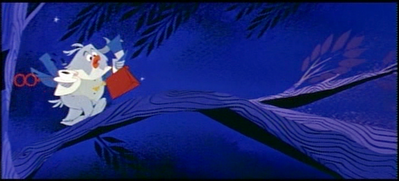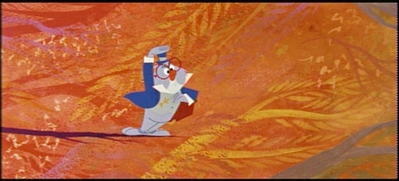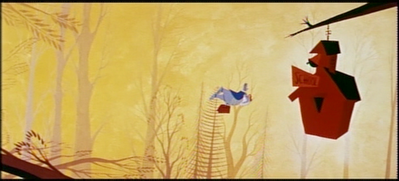Here's one that drives me crazy: THEY CHANGE THE COLORS
 This opening to Toot Whistle Plunk and Boom used to be beautiful.
This opening to Toot Whistle Plunk and Boom used to be beautiful.It was a pan where the color families changed gradually as the owl ran down a branch to the schoolhouse.
Originally all the colors were grayed down and had many subtle tints and hue variations in it. I used to get my BG artists to study it and apply the ideas to my cartoons. I must have watched the cartoon a hundred times.
It was gorgeous.
WAS...
Then they did this to it.
 Now it's all primary and secondary colors turned up to the brightest vulgarest saturation and all the fun is gone.
Now it's all primary and secondary colors turned up to the brightest vulgarest saturation and all the fun is gone. The BG colors are so over saturated and glowing that they bleed into the character.
The BG colors are so over saturated and glowing that they bleed into the character.
Toot Whistle Plunk and Boom was a grand experimental film by Ward Kimball, Tom Oreb, Eyvind Earle and other mighty Disney talents.
It has been turned into a modern gaudy looking Saturday morning cartoon.





The backgrounds in the classroom scenes were originally all subtle greyed colors too, and now they have been arbitrarily changed into purples, oranges, blues and other neon colors.
You can barely make out the characters against the backgrounds anymore because every color is equally bright and right in the middle of the hue.
These are the latest video transfers that are on those silver box sets-"Treasures" or whatever they are called.
Well the treasures have been destroyed.
Here are some other strange digital "restoration" tricks that they use to take the fun out of the cartoons.
LINE SHARPENING
They take the lines in the cartoons and thin them out. To the point where they are so skinny, that you can see the video scan lines cut through them. Now the once beautifully inked lines have ragged edges. The BG colors bleeds over them on one side, and the interior character colors bleed into them.PULSATING VIBRATING COLORS
I don't know exactly what they do here or why, but the colors vibrate in intensity-even when you still frame them. The Looney Tunes box sets do this too. It makes it really hard to follow the characters when they are pulsating, strobing and the ragged edges shimmer and shake up and down the outlines.MOIRE (MO-RAY) PATTERNS
Inside the flat cell colors, you see all kinds of electrical patterns dancing around. They look like when you put a dot tone on top of another and you get weird otherworldly patterns.DVNR
Many of the cartoons on the treasures are DVNR-ed. That Moose cartoon is particularly bad.UPPING THE CONTRAST
We met with someone who actually worked on these transfers and she told us they purposely changed all kinds of things in the old films. One of the things they do automatically is to up the contrast.This means that dark colors turn black and you lose lots of detail in the BGs.
GRAIN SMOOTHING
You ever see when all of a sudden the film grain freezes in an old film?Now they try to smooth away all the grain and while the grain gets polished off, so does the painting details in the backgrounds.
Sometimes you can make out the film grain in the background, but none in the characters and that creates a really strange fakish effect.
STROBING
Everything strobes now in modern film transfers of old cartoons. Especially during pans. Bambi jitters and shakes all over the place. That movie was once noted for its smooth naturalness and flowing animation. Now it looks like a modern made for TV video.The BGs have turned black. The lines are all jagged and too skinny and everything strobes.
CHANGING THE SOUND MIX
They remix the sound so that everything happens way in the distance. All the original careful balances and rich choreography of sound is gone. You have to really strain your ears to hear what's going on. Everything sounds like a modern MTV video mix now. The voices have lost their contrasts in volume and color and so have the sound effects and music.It sounds really digital and whispery.
Well it's all very depressing. My guess is that within another 10 years, these films will be completely unrecognizable as they keep coming up with new digital toys to help engineers change the art that the original artists made. Soon they will invent :"on-modelization" and they will go in and change all the character designs in the cartoons to make them match the current licensing guides. Bambi will wear a backwards baseball cap and all the forest creatures will rap the story.
Is there a site somewhere where someone documents all this destruction and tampering?
Is there anything we can do to stop it?
The best video transfers I have seen in the last 10 years are the ones done by cheap fast houses, who basically just telecine the films and don't tamper with anything, but that's all becoming ancient lost history now.
Better save all your video tapes and laser disks from the 80s and early 90s. Those are as close to the original films as you will ever see.
Or get over to the Asifa Archive and see the best possible available existing prints of rare films.

